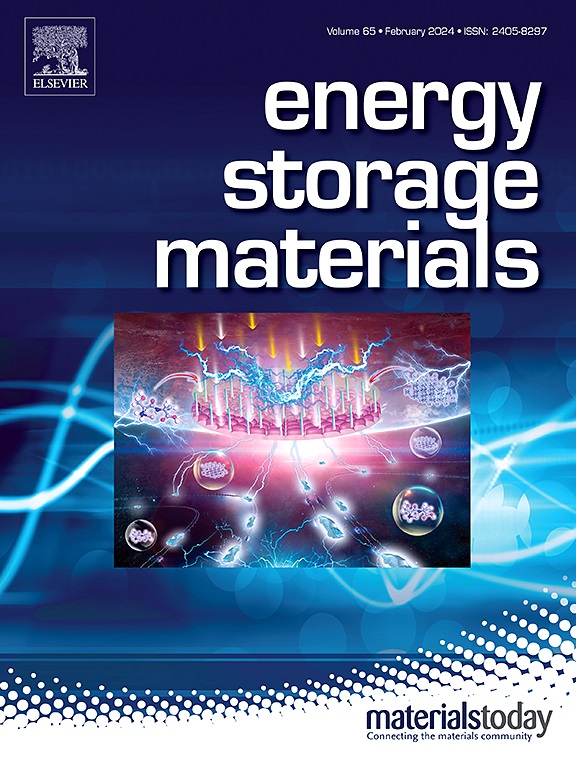Interplays between TM migration, cation mixing and oxygen defects and their impacts on degradation of layer-structured oxide cathode materials
IF 18.9
1区 材料科学
Q1 CHEMISTRY, PHYSICAL
引用次数: 0
Abstract
The Li-rich and Ni-rich layer-structured transition metal (TM) oxide cathode materials have attracted extensive attention due to their high energy densities. However, they suffer from rapid structural and performance degradations due to TM migration and oxygen loss during cycling. Herein, the structured LiNiO2 was investigated as a model of the layered oxides to reveal their structural features and structural degradation mechanisms. On the basis of comprehensive characterizations, we attributed the lowering of the TM oxidation potential to the deteriorated Li/TM cation mixing and the resultant change of the phase transition pathways. Notably, the cation mixing was found deteriorated even at a very low dosage of Li extraction and is enhanced with generation of extra oxygen vacancies at high potentials. Density functional theory (DFT) calculations explain the self-restriction of the Ni migration as well as these observations. Our findings clarify the mutual reinforcement between the TM migration, cation mixing and oxygen redox: the intrinsic and extrinsic Li/TM cation mixings result in the formation of Li-O-Li and/or Li-O-VacTM configuration(s) (VacTM for TM vacancy) and induce the oxygen oxidation, while the formation of oxygen vacancies further facilitate Ni migration by lowering its oxygen coordination. Clarification the relationship of TM migration, oxygen redox and structural degradation of LiNiO2 and the Ni-rich materials provides a new insight for the development of other layer-structured oxide cathode materials.

TM迁移、阳离子混合和氧缺陷的相互作用及其对层状结构氧化物正极材料降解的影响
富锂和富镍层状结构过渡金属(TM)氧化物正极材料因其高能量密度而受到广泛关注。然而,由于TM迁移和循环过程中的氧损失,它们的结构和性能会迅速下降。本文研究了R3¯mR3¯m结构的LiNiO2作为层状氧化物的模型,揭示了其结构特征和结构降解机制。在综合表征的基础上,我们将TM氧化电位的降低归因于Li/TM阳离子混合的恶化以及由此导致的相变途径的改变。值得注意的是,即使在很低的Li萃取剂量下,阳离子混合也会恶化,而在高电位下产生额外的氧空位则会增强阳离子混合。密度泛函理论(DFT)的计算解释了Ni迁移的自约束以及这些观测结果。我们的研究结果阐明了TM迁移、阳离子混合和氧氧化还原之间的相互增强:内在和外在的Li/TM阳离子混合导致Li- o -Li和/或Li- o -VacTM构型的形成(VacTM表示TM空位)并诱导氧氧化,而氧空位的形成通过降低其氧配位进一步促进Ni迁移。阐明LiNiO2的TM迁移、氧氧化还原和结构降解与富镍材料的关系,为开发其他层状结构氧化物正极材料提供了新的思路。
本文章由计算机程序翻译,如有差异,请以英文原文为准。
求助全文
约1分钟内获得全文
求助全文
来源期刊

Energy Storage Materials
Materials Science-General Materials Science
CiteScore
33.00
自引率
5.90%
发文量
652
审稿时长
27 days
期刊介绍:
Energy Storage Materials is a global interdisciplinary journal dedicated to sharing scientific and technological advancements in materials and devices for advanced energy storage and related energy conversion, such as in metal-O2 batteries. The journal features comprehensive research articles, including full papers and short communications, as well as authoritative feature articles and reviews by leading experts in the field.
Energy Storage Materials covers a wide range of topics, including the synthesis, fabrication, structure, properties, performance, and technological applications of energy storage materials. Additionally, the journal explores strategies, policies, and developments in the field of energy storage materials and devices for sustainable energy.
Published papers are selected based on their scientific and technological significance, their ability to provide valuable new knowledge, and their relevance to the international research community.
 求助内容:
求助内容: 应助结果提醒方式:
应助结果提醒方式:


